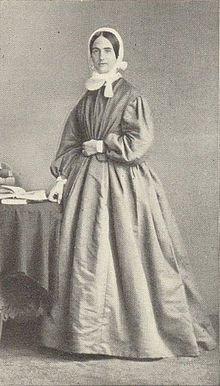Elizabeth Ferard
Elizabeth Ferard (born February 22, 1825 ; died April 18, 1883 in London ) was the first English woman to be consecrated as a deaconess in the Anglican Church . At the same time she was the head of the first English deaconess institution founded in 1861 ( North London Diocesan Deaconess Institution , later renamed Community of St. Andrew ).
Live and act
Elisabeth Ferard came from a wealthy family with Huguenot roots. Her father was the lawyer Daniel Ferard (1788-1839). Like many of her wealthy contemporaries, Ferard went on an educational journey through continental Europe at a young age . Her visit to the first deaconess institution in Kaiserswerth (near Düsseldorf ) in 1856 , which was founded in 1836 by pastor Theodor Fliedner and his wife Friederike Fliedner , was formative for her later life . Ferard recorded the impressions she gained here in a diary. Such a stay in Kaiserswerth was nothing special at the time. On the contrary: Countless Inner Mission protagonists from Great Britain (and all of Europe) visited Kaiserswerth in the 19th century - perhaps the most prominent among them was Florence Nightingale .
Inspired by her journey, Ferard set out to found the North London Diocesan Deaconess Institution (NLDI), which took place in 1861. Ferard was the preceding sister ( Head Sister ) of the institution, her brother-in-law Reverend Thomas Pelham Dale (1821-1892) acted as the chaplain. The NLDI - renamed the London Diocesan Deaconess Institution in 1868 and, since 1943, the Deaconess Community of St Andrew - was closely based on the model of the Kaiserswerther Diakonie in the early years . The sisterhood ran a small infirmary where single women who entered were trained in nursing. A uniform costume served to strengthen the sense of community and the visibility of the sisterhood to the outside world. The deaconesses led a life in religious community under the guidance of the head sister and the chaplain. Ferard was able to largely prevail with her conceptual ideas. Not least because of this, Dale resigned from his office in 1868, after which Ferard managed the sisterhood almost independently. During these years, the institute diverged more and more from its German model.
In 1873 Ferard retired from her post for health reasons. She later headed a convalescent home for sick children in Redhill ( Surrey ). She died in London in 1883.
The NLDI became in the 19th century the largest and thus most important English deaconess institution. In the years that followed, other institutions were founded in the following years, including in Bedford (1869), Chester (1869), Canterbury (1874) and Salisbury (1875). Nevertheless, the female diakonia in England never achieved a comparable importance as in Germany, which was partly due to the fact that secular, professional nursing was established in England at an early stage .
literature
- Blackmore, Henrietta (ed.): The Beginning of Women's Ministry. The Revival of the Deaconesses in 19th-Century Church of England (= Church of England Record Society 14), Woodbridge 2007.
- Bonham, Valerie: Ferard, Elizabeth Catherine (1825-1883). In: Oxford Dictionary of National Biography (ODNB). From the earliest times to the year 2000 . Vol. 19th ed. Henry Colin Gray Matthew et al. Brian Harrison. Oxford [u. a.] 2004, pp. 334-335.
- Czolkoß, Michael: "I see some things that could damage the success of the deaconess thing in England" - English Ladies and the Kaiserswerther motherhouse diakonia in the 19th century . In: Between Enlightenment and Modernity. Awakening movements as a historiographical challenge (Religion - Culture - Society. Studies on the cultural and social history of Christianity in modern times and modern times, 5), ed. v. Thomas K. Kuhn and Veronika Albrecht-Birkner . Münster 2017, pp. 255–280.
Individual evidence
- ↑ Ferard, Elizabeth: Journal of a residence at Kaiserswerth on the Rhine, 1856. In: Blackmore, Henrietta (ed.): The Beginning of Women's Ministry. The Revival of the Deaconesses in 19th-Century Church of England (= Church of England Record Society 14), Woodbridge 2007, pp. 3-37.
- ↑ For the similarities and differences see: Gerhardt, Martin : Theodor Fliedner. Ein Lebensbild, Volume 2 , Düsseldorf 1937, pp. 787–788.
- ↑ See also: Grierson, Janet: The Deaconess , London 1981.
| personal data | |
|---|---|
| SURNAME | Ferard, Elizabeth |
| BRIEF DESCRIPTION | English deaconess |
| DATE OF BIRTH | February 22, 1825 |
| DATE OF DEATH | April 18, 1883 |
| Place of death | London |
